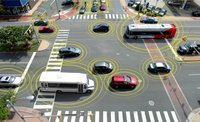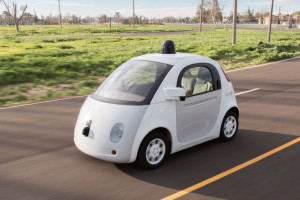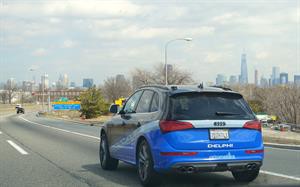A Few More Steps Toward Taking Your Hands Off the Wheel
Whether it’s Google’s little “horizontal elevators” or Audi’s “driving” across the country with no driver input, it’s hard to find a story on advanced automotive technology that doesn’t touch on the coming of the autonomous or self-driving car. Well, we hate to tell you, but that fantastical version of future transportation is already here–at least in bits and pieces. Those bits and pieces, which represent significant advances in technology individually, also are in the process of adding up to a car that can pilot itself with minimal help from a human.
Safety concerns have led automotive manufacturers to design an ever-increasing number of advanced driver assistance systems (ADAS is a new acronym to learn that describes these technologies) that make cars safer and easier to drive. The end goal is fewer accidents, injuries and deaths, something insurance companies and the federal government both champion.
These new technologies are following seatbelts, air bags and anti-lock braking systems that started as options and then quickly became mandatory on all new cars. The driver assistance systems we are seeing now as options or part of packages will undoubtedly become standard equipment in the coming years. For many of these technologies becoming mandatory can’t come soon enough, especially as the Baby Boomer population bubble ages.

The ADAS discussed here may carry different names from manufacturer to manufacturer, so when shopping for your next car ask to see the list of these technologies to determine exactly what is available. One rule of thumb is that the more expensive the car, the higher the possibility you will find these – and maybe others – either as options or standard equipment.
Adaptive Cruise Control
An on-board sensor-controlled radar system that automatically adjusts your car’s speed to keep a safe distance from the cars ahead. Adaptive Cruise Control does not use GPS, road sensors or other infrastructure, or require communication with any other vehicle to operate.
Adaptive Steering
Power steering is common on all vehicles, helping drivers turn without needing to go to the gym first. Adaptive Steering does something different by adjusting the steering based on different driving conditions. When at low speeds, for example, Adaptive Steering helps you turn the wheel fewer times to get to your end destination and makes the car easier to turn, especially when parking.

Advanced Brake Assist
This system works in conjunction with Forward Collision Warning and the Collision Mitigation Braking System to assist in bringing your car to a safe stop in an emergency. Through sensors, Advanced Brake Assist recognizes a panic stop is taking place and works with the Anti-Lock Braking System (ABS) to reduce stopping distances and help the driver keep the car under control.
Automatic/Adaptive High Beam Control
In an attempt to reduce the limited visibility of driving at night, Automatic/Adaptive High Beam Control systems are designed to increase the vehicle’s high beam headlights efficiency so that pedestrians, signs, bicyclists, road hazards and configurations, and other vehicles are more visible. The technology uses sensors to read light sources, whether it be from oncoming vehicles or approaching a slower car.
Automatic Post-Collision Braking System
During an accident, your car does not always stop immediately. An Automatic Post Collision Braking system, used in conjunction with the air bag sensors, automatically engages the brakes after a collision, slowing the car to approximately 5 mph to prevent subsequent higher speed impacts.
Automatic Rollover Protection System
What driver of a convertible hasn’t wondered what protection is there in a roll-over crash? Several manufacturers have an Automatic Rollover Protection system that uses the crash sensors from the air bag control unit to deploy rollover bars, either behind the front seats or rear seats depending if the car is a two or four passenger model. These deploy in less than a quarter of a second and, in conjunction with the reinforced windshield A-pillar, provides excellent protection to the car’s occupants.
Blind Spot and Lane Departure Control System
If adjusted properly and used correctly, outside rear view mirrors will provide the necessary vision to eliminate any blind spots, especially on the rear of the passenger side. But, as we all know, most mirrors are either not adjusted correctly or used properly, if even at all. A Blind Spot and Lane Departure Control system provides either a visual (flashing lights in the outside rear view mirrors), audible (beeping) or tactile (vibrating of the driver seat or steering wheel) to alert the driver that an object is in an area that could cause an impact if your car continues to either drift from its lane or during a lane change. The system is cancelled when using the turn signals. This is probably the most useful of all the ADAS Technology systems that will keep you out of a collision.

Forward Collision Warning/Avoidance System
Used in conjunction with an Adaptive Cruise Control system, a Collision Avoidance System (also called a Collision Mitigation Brake System) is radar-based technology designed to avoid a frontal collision. Some systems use lasers and cameras, but these, unlike radar, are ineffective in poor weather. When approaching a car going the same direction and in the same lane, the system’s first alert will be through visual warnings of flashing lights on the instrument panel and audibly, usually a beeping. If you continue to approach at an unsafe closing speed the visual and audible warnings increase in intensity and there is a light application of the brakes. If none of these has drawn your attention, the visual and audible warnings continue, followed by a stronger application of the brakes.
Cross Traffic Alert System
This technology, usually packaged with the Blind Spot monitoring system and a Rear View Camera, is very handy when backing out of a parking space. The Cross Traffic Alert system engages when your car is placed in reverse and sensors in the rear bumper detect a moving object on either side of the car. Warnings will be beeps and a flashing light in the outside rearview mirrors.
Parallel Park Assist
This one is fun! When parallel or perpendicular parking, you turn-on the system and it automatically determines if a space is large enough for your car. Once it finds a suitable space and you place the car in reverse, the system takes over control of the steering wheel and guides your car into the parking space. You will still be required to apply the brakes.
Rain-Sensing Windshield Wipers
For those of you who can’t figure out when it is necessary to turn on your windshield wipers, a Rain-Sensing Windshield Wiper system is just what you need. This system works through an optical sensor that determines when water is on the windshield and if the wipers should be operating.
Rear-view Camera with Rotating Outside Mirrors
Rear-view cameras, now available on almost all cars (and mandatory starting in mid-2018), are activated when placing a car in reverse and work well once the driver gets used to the perspective of the wide angle lens. The rear-view camera is even more effective is when it is paired with automatic outside mirrors that rotate downward when the car is in reverse. The combination of the two solves a major problem when backing-up, especially when parking with no cars on either side of your car. The downward facing mirrors look directly at the painted lines, so along with using the rear-view camera, you are able to easily center your car and stop backing before banging into something.
There are other related technologies available such as adaptive lights that turn into a curve, crosswind stabilization, night vision systems, driver drowsiness detection, hill descent controls and traffic sign recognition systems.

Availing yourself of the ADAS offered in the market is becoming a no-brainer. When car shopping, do not scrimp on the monthly payment by failing to take advantage of a safety device that might save your life, that of passengers in your car or even other drivers on the road.
Everyone on the road will benefit and thank you for being a safer driver, even if it took a computer and sensor to get you there.
Related Stories You Might Enjoy:
Safer & Self-Driving Cars Now on the Road
Elon Musk on the Near Future of the Autonomous Car
New Autonomous Cars & Connected Mobility

4 thoughts on “On the Way to the Self-Driving Car–Advanced Driver Assistance (ADAS) Technology”